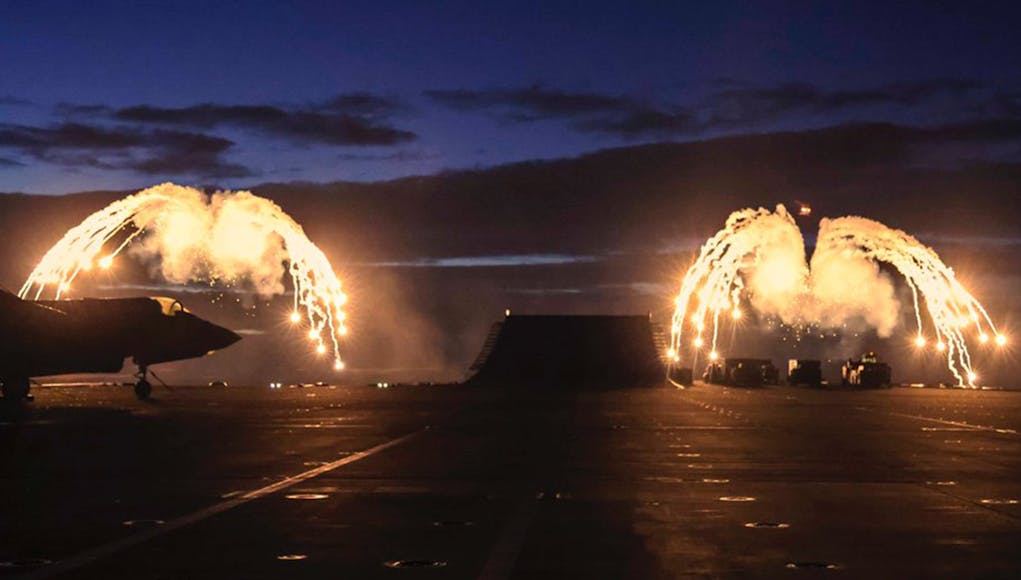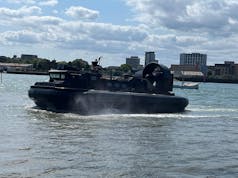Wildcats from HMS Queen Elizabeth have fired flares near the carrier.
In addition to marking the first time flares were loaded and fired from a helicopter flying from a Queen Elizabeth class carrier, it proved to be a stunning display.
The official account of the United Kingdom Carrier Strike Group, currently commanded by Commodore James Blackmore Royal Navy (COMUKCSG), tweeted the following.
The Wildcats from @847NAS show their defensive skills 💥
This is the first time two Wildcats have conducted night DAS from @HMSQNLZ.#UKCSG23 #WeAreNATO pic.twitter.com/3Tth8DUbbR
— UK Carrier Strike Group (@COMUKCSG) November 9, 2023
What is the Carrier Strike Group doing?
The UK Carrier Strike Group, led by flagship HMS Queen Elizabeth, recently completed the first phase of its autumn deployment. This involved participating in a series of simulated strike missions in the North Sea and Norwegian Sea alongside international naval partners.
“HMS Queen Elizabeth and her embarked jets and helicopters have proven their ability to provide the “punch” of the UK Carrier Strike Group during a series of simulated strike missions alongside international partners”, the press release stated.
Joining the aircraft carrier for these combat simulations were several ships from the UK and allied nations. Among these were the Type 45 destroyer HMS Diamond, Royal Fleet Auxiliary tanker RFA Tideforce, Norwegian ships HNoMS Otto Sverdrup and HNoMS Maud, Dutch ships HNLMS De Zeven Provincien and HNLMS Van Amstel, and the Belgian frigate BNS Louise Marie.
The exercises featured HMS Queen Elizabeth’s F-35 Lightning fighter jets from 617 Squadron, Merlin helicopters from 820 Naval Air Squadron, and Wildcat helicopters from 815 and 847 Naval Air Squadrons. Their missions varied, ranging from defending against aerial threats to suppressing enemy air defences and executing strike attacks.
Additionally, HMS Queen Elizabeth and her Carrier Strike Group showcased their medical capabilities, including advanced resuscitation techniques, trauma surgery, and casualty evacuations.
The next phase of the deployment will feature UK forces collaborating with ships and personnel from Joint Expeditionary Force (JEF) nations, which include countries such as Denmark, Estonia, Finland, Latvia, Lithuania, the Netherlands, Norway, and Sweden.
Commodore James Blackmore, Commander of the UK Carrier Strike Group, was quoted as saying, “CSG23 is off to a great start. Integrated training within the air and maritime environments, and alongside our European allies, has demonstrated the capability and agility of UK Carrier Strike.”
“Integrated training within the air and maritime environments, and alongside our European allies, has demonstrated the capability and agility of UK Carrier Strike”, reaffirmed Blackmore.














Oooh, pretty lights. 🤗😁
Aaah So Woo
HMS Dragon with a Wildcat doing the same thing a few years ago ‘breathing fire’ in the evening light was Wow
So many superlatives 😀
I am fairly sure that this was not a firework display !
Perhaps a serving or ex-RN expert could confirm, or otherwise, that this was an exercise in utilising flares as an anti-drone/missile ‘last resort’ defence ?
The article explains what it is.
NO. it does not, absolutely in no way whatsoever. Why Wildcat ? Why adjacent to the carrier ? Why now ? What is the assessed ‘threat’ or ‘threats’ ??
Do you know what would be a stunning display over a QE? 😉
A tangent to this article but still naval is the recent notice by the Japan to build 12 new Mogami class frigates between 2024-2028 (rate of 2 per year).
The new frigates are set to be “improved” versions of previous Mogami-class ships, fitted with longer-range missiles, enhanced anti-submarine systems, and a new ship-to-air guided missile. The ships will have a standard displacement of up to 4,880 tons and an overall length of 142 meters. Although the ships will be bigger, crew size will remain the same at 90.
Knowing the Japanese, these will be built on time and within budget.
They’re also keeping their 5″ main guns. There’s the same option for the A140/T31 if we choose.
Why? Is this a defensive tactic?
It looks pretty and it’s near fireworks night?
Good to see the airborne decoys but what decoys (besides ECM) are onboard the carriers? Does anyone here know?There doesn’t seem to be any at the moment. You’d think a few Ancilia type mounts or even fixed decoys would do the trick?